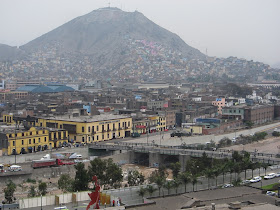We spent three days in Lima, the capital and biggest city of Peru, located on the coast of the Pacific Ocean. The city is sprawling and chaotic, not very beautiful except for some colonial monuments, and intriguing churches and monasteries.
Plaza de Armas
View over Lima from the Iglesia de Santo Domingo
The monasteries kept some signs of colonial greatness, various tombs and bone-chilling catacombs...

Catacombs at the Convento de San Francisco
... while the churches have a funny touch of kitsch for our European eyes:
Christmas crèche (with Barbie's boyfriend in sleeveless tee-shirt!)
at the Basilica Menor de Nuestra Señora de la Merced de Lima
At the Basilica Menor de Nuestra Señora de la Merced de Lima
Iglesia de San Francisco
The catedral de Lima stands on the spot designated for the city's first church by Francisco Pizarro. This Spanish conquistador founded the city in 1535. His remains rest in a rich chapel of the cathedral. His figure is quite controversial; he is seen as the leader behind the fall of the Inca empire and despised for having ordered the death of the last Inca emperor even if his ransom (a room filled with gold and two filled with silver) was duly paid.
Francisco Pizarro's chapel
Description of Francisco Pizarro's bone injuries
We also made the most of our days in Lima by trying some local specialties:

The ceviche (marinated fish and seafood) maybe the most famous Peruvian dish
next to the cuy (guinea pig)!
next to the cuy (guinea pig)!
The ever-present Inka Kola which tastes like a candy we could not identify
******
Anyway travelers in Peru are not attracted by Lima. The city is more like a landing point before heading toward exotic destinations, for example the highest navigable lake in the world, Lake Titicaca (3.808m).

Covering 8.400 square kilometers Lake Titicaca straddles Peru and Bolivia and hosts colorful and historical communities on many islands. On an organized one day trip, we went to meet some islanders living on the Isla flotante (floating island) Los Uros.
Women welcoming us at Manco Capac
In fact Los Uros are rather composed of several islands. Each man-made island is inhabited by a handful of families. During the last few years tourism became an important source of income for those families.

We landed on one of the floating island, Manco Capac, and our guide explained us the local way of life, helped by the head of the community. At the end of the presentation, some women came and took by hand each one of us to show their houses and then try to sell us their craft production. We felt somehow embarrassed and out of place.
Then the head of the community offered us a boat ride against an "extra". Actually the locals told us they called the boat their Mercedes Benz as they make so much money with it! Well we thought the whole experience was enriching as there is still a genuineness in the way this community lives. However we wondered how long it could last.
The local Mercedes Benz
Our second and last stop on the Lake Titicaca was for the Isla Taquile. This island became world-recognized when the UNESCO proclaimed "Taquile and Its Textile Art" a "Masterpieces of the Oral and Intangible Heritage of Humanity". And, surprisingly enough, the knitting is only performed by men!

Isla Taquile















Joyeux Noël!!!
ReplyDeleteEric de Paris!
C'est plus Eric de New York?? Passe un très bon Noël aussi! Gros bisous
ReplyDelete